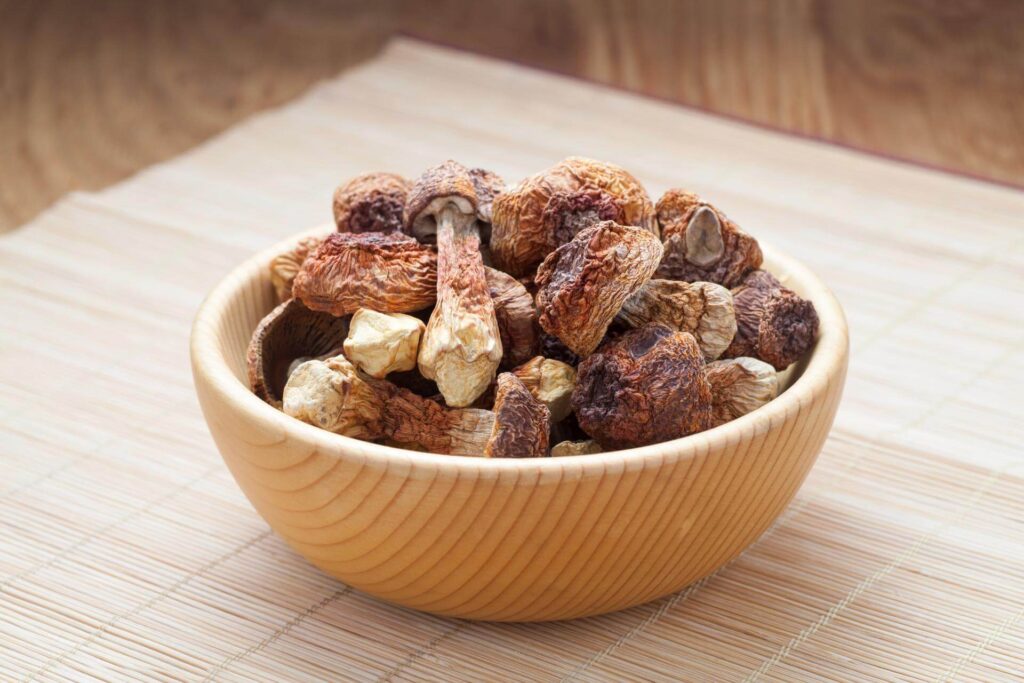Not all mushroom supplements are created equal. In fact, many don’t contain much of the mushroom at all.
If your supplement says “mushroom” on the label, you might assume you’re getting the whole mushroom. But in most cases, you’re actually getting mycelium—the root-like structure that grows underground—often grown on grain and harvested before a true mushroom even forms.
So, what’s the difference between fruiting body and mycelium? And why does it matter when you’re trying to support your health?
Let’s clear things up.
Fruiting Body vs. Mycelium: A Quick Overview
- Fruiting body = the full, mature mushroom (cap + stem) you see above ground
- Mycelium = a web of root-like filaments, often grown in plastic bags on sterilized grain
While mycelium is part of the mushroom life cycle, it’s not the part used in traditional herbal medicine. And it doesn’t offer the same concentration of bioactive compounds.
What the Fruiting Body Contains
The fruiting body of Agaricus blazei Murrill (ABM) is rich in:
- Beta-glucans that support immune modulation
- Ergosterol (a vitamin D2 precursor)
- Antioxidants and enzymes
- Triterpenes, polysaccharides, and amino acids
- Over 190 nutrients that help nourish your cells
Mycelium, especially when harvested early, contains far fewer of these beneficial compounds—and much more of the starchy grain it was grown on. That’s why some mycelium products contain only a fraction of actual mushroom compounds.
What the FDA Says About Labeling
According to FDA regulations (21 CFR § 101.4), if a product is made from mycelium, the label must clearly state “mycelium” or “mycelial biomass.”
It may not be labeled simply as ‘mushroom’ unless it is made from the fruiting body.
Despite this, many companies label mycelium-based products as if they contain the actual mushroom—misleading customers who are trying to make informed choices.
The USP Reishi Study: A Wake-Up Call
In 2017, the United States Pharmacopeia (USP) tested 19 Reishi mushroom supplements.
- 👉 Only 5 of them contained actual Reishi fruiting body compounds
- 👉 The remaining 75% contained mostly grain starch and no detectable Reishi markers
- 👉 Many were labeled “Reishi mushroom,” even though they only contained mycelium-on-grain
Source: NutraIngredients-USA summary of USP study link is here https://pubmed.ncbi.nlm.nih.gov/28798349/
Because this kind of mislabeling is so common, we created Desert Forest Nutritionals® to offer an honest alternative—pure fruiting body extracts, processed the traditional way.
What Sets Desert Forest Nutritionals® Apart
We believe in transparency, tradition, and trust. That’s why we:
- Use only Brazilian-grown, non-hybridized fruiting bodies
- Never use mycelium, maltodextrin, or grain-based fillers
- Rely on a dual-extraction method (hot water + alcohol) to concentrate both water- and alcohol-soluble compounds
This is the same part of the mushroom that has been used in clinical studies, and the same preparation method used in traditional medicine.
Why This Matters for Results
If you’re using mushrooms for wellness support—whether for immune function, energy, or recovery—the quality and identity of the extract matter.
Fruiting body extracts deliver the full spectrum of nutrients that nature intended.
Mycelium-on-grain does not.
Your health is worth more than powdered starch.
The Desert Forest® Standard
Since 2002, we’ve specialized in fruiting-body-only ABM extracts from Brazil.
We offer:
- Clinical-grade purity
- No shortcuts or cheap fillers
- Transparent sourcing and preparation methods
We don’t believe in “mushroom-like” products. We believe in whole, authentic mushrooms—grown, harvested, and prepared the way they’ve been used for centuries.
Bibliography
- Li, S. et al. (2022). Chemical compositions and health-promoting effects of Agaricus blazei Murill. Molecules, 27(23), 8559.
- Mizuno, T. (1995). Agaricus blazei Murill: medicinal and dietary effects and cultivation techniques. Food Reviews International, 11(1), 69–85.
- Wu, D. et al. (2017). Evaluation of Ganoderma supplements using chromatographic and DNA-based methods reveals widespread adulteration with starch products.
- Beelman, R. et al. (2020). Mycelium vs. Fruiting Body: What’s in Your Mushroom Supplement?
Medicinal - FDA (21 CFR § 101.4) – Food labeling; designation of ingredients.
FDA Regulation

